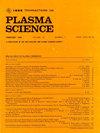基于PIC方法的带电液滴种群聚结生长数值模拟
IF 1.3
4区 物理与天体物理
Q3 PHYSICS, FLUIDS & PLASMAS
引用次数: 0
摘要
加速云滴之间的碰撞和聚并过程是促进催化降雨的必要条件,具有解决水资源短缺的潜力。带电液滴播种降雨由于电的吸引,可以加速液滴的碰撞和聚并。同时,与使用催化剂的传统降雨相比,带电液滴播种降雨具有更复杂的碰撞和聚并行为。本文采用二维细胞内粒子(PIC)模拟研究了液滴种群(10000个液滴)的充电特性(包括电荷量、充电比和不同电荷极性)和外电场对液滴种群聚并生长规律的影响。结果表明:在120s时,电荷量为0的液滴群的有效直径%, 5%, and 10% ${q} _{\max }$ increased by 10.2%, 191.1%, and 476.8% compared with the initial value at 0 s, respectively. A suitable proportion of bipolar droplet populations, such as 75% negatively charged droplets and 25% positively charged droplets, has a better effect on promoting droplet coalescence in the early stages compared with the unipolar droplet population with 100% negatively charged droplets. The proportion of large droplets (diameter $\ge 25~\mu $ m) increases with the charge amount, charged ratios, and external electric field strength. The research results of PIC-simulated droplet coalescence provide theoretical guidance for understanding the temporal evolution of droplet size in droplet population collision and the efficient promotion of large droplets to some extent.本文章由计算机程序翻译,如有差异,请以英文原文为准。
Numerical Simulation of Coalescence Growth of Charged Droplet Population Based on PIC Method
Accelerating the collision and coalescence process between cloud droplets is essential in promoting the catalytic rainfall, which has the potential to solve the shortage of water resources. The charged droplet seeding rainfall can accelerate droplet collision and coalescence due to the attraction of electricity. Meanwhile, the charged droplet seeding rainfall has a more complex collision and coalescence behavior than traditional rainfall using catalysts. In this article, 2-D particle-in-cell (PIC) simulation is used to study the effect of droplet population (10 000 droplets) charging characteristics (including charge amount, charged ratio, and different charge polarities) and external electric field on the growth law of droplet population coalescence. The results show that at 120 s, the effective diameters of droplet populations with charging 0%, 5%, and 10% ${q} _{\max }$ increased by 10.2%, 191.1%, and 476.8% compared with the initial value at 0 s, respectively. A suitable proportion of bipolar droplet populations, such as 75% negatively charged droplets and 25% positively charged droplets, has a better effect on promoting droplet coalescence in the early stages compared with the unipolar droplet population with 100% negatively charged droplets. The proportion of large droplets (diameter $\ge 25~\mu $ m) increases with the charge amount, charged ratios, and external electric field strength. The research results of PIC-simulated droplet coalescence provide theoretical guidance for understanding the temporal evolution of droplet size in droplet population collision and the efficient promotion of large droplets to some extent.
求助全文
通过发布文献求助,成功后即可免费获取论文全文。
去求助
来源期刊

IEEE Transactions on Plasma Science
物理-物理:流体与等离子体
CiteScore
3.00
自引率
20.00%
发文量
538
审稿时长
3.8 months
期刊介绍:
The scope covers all aspects of the theory and application of plasma science. It includes the following areas: magnetohydrodynamics; thermionics and plasma diodes; basic plasma phenomena; gaseous electronics; microwave/plasma interaction; electron, ion, and plasma sources; space plasmas; intense electron and ion beams; laser-plasma interactions; plasma diagnostics; plasma chemistry and processing; solid-state plasmas; plasma heating; plasma for controlled fusion research; high energy density plasmas; industrial/commercial applications of plasma physics; plasma waves and instabilities; and high power microwave and submillimeter wave generation.
 求助内容:
求助内容: 应助结果提醒方式:
应助结果提醒方式:


